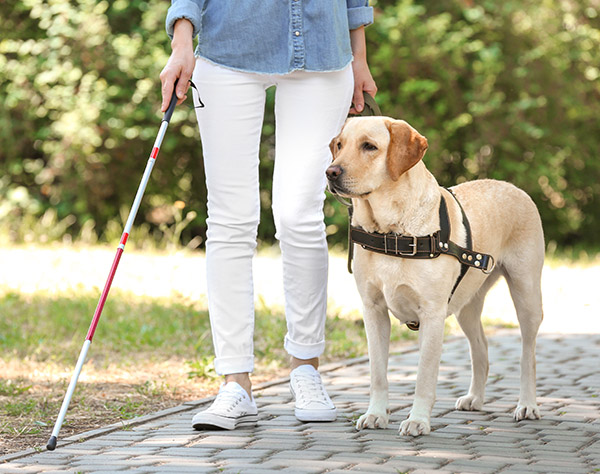
The past few months have challenged all of us as we struggle to come to terms with a major pandemic. Adaptations to keep ourselves and our community safe have disrupted our employment and education, the way we shop, our leisure activity and the ways we interact with family, friends and strangers.
But for those who are blind or visually impaired, the challenges escalate disproportionately. How can you socially distance when you rely on someone else to guide you by touch? If you are unable to drive, how can you access drive-through only services, including COVID-19 testing sites? How can students continue their education if their district has not addressed accessibility in their online learning? The stress of adapting to these conditions is heightened by the fact that blindness is often the result of other immunity compromising conditions, such as diabetes and aging, which put these individuals in a high risk category if they contact the disease.
Even accessing news updates on COVID-19 has proven difficult, since the information is often displayed as graphics and charts which are rarely available in accessible formats. But the fundamentals of daily living – finding transportation, receiving medical treatment, shopping for groceries and supplies, maintaining employment and education and voting safely – have often become daunting tasks.
Disruptions to public and private transportation services have had an outsized impact on individuals who are visually impaired who rely on them. Many public transportation systems have reduced services and are limiting the number of passengers to maintain social distancing. Companies such as Uber and Lyft have reduced capacity due to drivers concerned about possible contact with COVID-19.
Not having access to transportation has indirect impacts as well. People on foot who are visually impaired have been denied service at restaurants, banks and other businesses, in violation of the Americans with Disabilities Act (ADA). The National Federation of the Blind has received numerous reports of discrimination against blind people who have tried to access drive-through windows on foot. (See Restaurants, Banks, and Others Denying Service to Blind Pedestrians.) One of the most concerning aspects of this is not having access to drive-through COVID-19 testing facilities. Ride-share drivers are unlikely to risk contact with a contagious individual to drive them to the testing center, and some testing centers are not allowing foot-access to the visually impaired.
Shopping for groceries and supplies presents one of the greatest challenges and greatest risks for those who rely on touch to identify an object. In-store assistance has been less available as store personnel deal with stocking for increased demand and crowd control. Delivery services may be overwhelmed by increased volume. Those who must shop in person are urged to take more stringent precautions than those advised for sighted people, such as wearing gloves and discarding them as soon as they return home.
There are some resources available to assist on these trips. The AIRA app connects individuals who are visually impaired to a trained visual interpreter who can guide them through their smartphone, including letting them know how close they are to other people and directing them to social distancing markers in stores. Be My Eyes is a similar app that connects those with visual impairment to sighted people willing to help.
The National Federation for the Blind (NFB) addresses some of these issues in Coming Together During COVID-19: Concerns and Connections. NFB offers a COVID-19 Resource Guide and is now including a coronavirus Breaking News section on its free electronic information system, NFB-NEWSLINE®, available to Americans who are legally blind and print-disabled.
The American Foundation for the Blind recently released the Flatten Inaccessibility Report, which illustrates the impact of COVID-19 on adults who are blind or visually impaired in the areas of transportation, healthcare, access to food and supplies, employment, education, and voting. The report surveyed participants to assess their concerns in those areas and suggests solutions for addressing those issues.
Blind students’ academic success has also been jeopardized as schools and higher education institutions turn to distance learning platforms in response to COVID-19. According to a report on WSAW-TV in Wausau, WI (For blind students anticipating virtual learning this fall, inaccessible learning platforms are top concern), “The 2020 Web Accessibility Annual Report found the vast majority of websites have compliance issues with the Americans with Disabilities Act, after a 2018 ruling by the Department of Justice ruled that websites, as public spaces, would have to comply with the 1990 law. For students with disabilities stuck in a virtual learning environment… inaccessible learning platforms could put schools at risk of violation of another federal act: The Individuals with Disabilities Education Act (IDEA).” Lack of accessibility and having to rely on sighted persons for learning could leave many blind students behind in the academic skills necessary to advance to the next level.
To make matters worse, Sen. Lamar Alexander (R-Tennessee) proposed that the Office of Special Education and Rehabilitative Services (OSERS) issue waivers to states that would allow schools not to comply with the Individuals with Disabilities Education Act (IDEA) for one year. (See AFB Is Fighting to Protect Rights of Blind and Low Vision Students During COVID-19 Pandemic.) Since IDEA does not permit OSERS the authority to waive these requirements. some Republican leaders in Congress tried to insert language into the first COVID-19 relief package that would have asked the Department of Education to send a report to Congress listing waivers they would like the authority to grant. Several organizations, including the American Federation for the Blind, successfully opposed that legislation. The OSEP website states that “OSEP reminds SEAs and LEAs that no matter what primary instructional delivery approach is chosen, SEAs, LEAs, and individualized education program (IEP) Teams remain responsible for ensuring that a free appropriate public education (FAPE) is provided to all children with disabilities.”
The AFB provides a link to Accessible Education Resources.
Guide dogs and service dogs are even more invaluable companions during this time, but they are unable to judge social distancing. Organizations like Canine Companions for Independence (Canine Companions for Independence Covid-19 update) are urging sighted persons to take responsibility for maintaining social distance with blind people. CCI has also adapted to the pandemic with their #SayHiChallenge. Instead of teaching guide dogs the “shake” command, which allowed the public to meet working service dogs in an appropriate manner controlled by their owner, CCI is now teaching the “say hi” command, which allows interaction from a safe distance by teaching service dogs to waive a paw. (Social Distancing Service Dogs Say Hi: Canine Companions® service dogs learn a new command to encourage social distancing) They are encouraging everyone to use the hashtag #sayhichallenge to share photos of their social distancing pet on Instagram, Twitter and Facebook.
Many of the recommendations for how to stay safe during this pandemic are the same for both sighted people and people who are visually impaired, but those with visual impairments should take additional precautions, such as frequently washing hands or using hand sanitizer, especially after touching surfaces or being guided by another person. Carrying a cane at all times or relying on a guide dog can reduce the need to touch surfaces or be guided by another person. The directive to routinely clean frequently touched surfaces includes walking canes, glasses, braille, mobile phones, dog harnesses, low vision devices etc. Wear plastic or disposable gloves outside, then throw them upon arriving home. And, of course, always wear a face mask.


